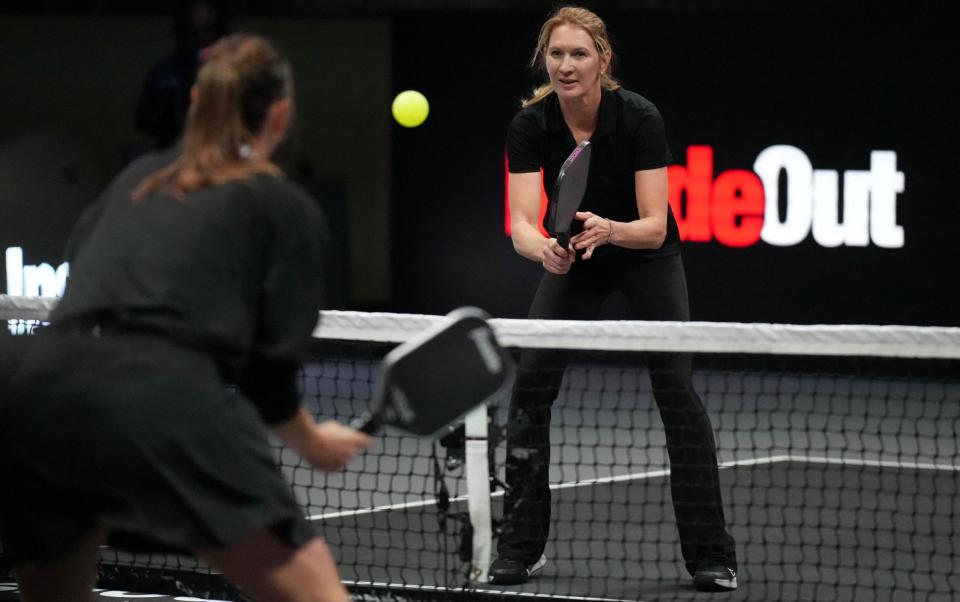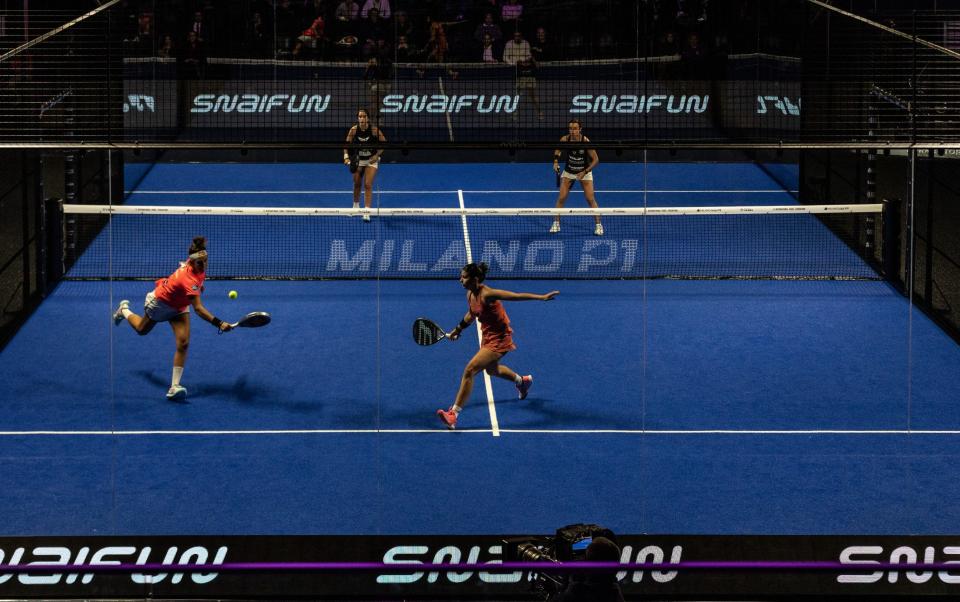Ever heard of pickleball? It’s a fast-paced, low-impact cross between tennis and ping pong and is America’s hottest emerging sport. Famous fans include former NFL quarterback Tom Brady, fashion diva Kim Kardashian and actor Leonardo DiCaprio.
So far, pickleball is still in its infancy on this side of the Atlantic. We have maybe 12,000 regular participants, compared to nine million in the United States. But it clearly has growth potential, which could explain why it has become the subject of a prickly custody battle.
With an upcoming Sport England board meeting to discuss the fate of pickleball, the new breed of racquet sports – which also includes the related discipline of padel – is heading into an intriguing few weeks.
The awkwardness stems from a simple question: Who should run pickleball in this country? Should it be the Lawn Tennis Association, which has been managing padel since 2019 – with questionable results, according to many insiders? Or should it be the group of enthusiastic volunteers who founded Pickleball England that same year?
This is the choice facing Sport England, which is expected to look at it again at the end of March. The issue was referred to in the House of Commons on Thursday, with Conservative MP Andrew Selous asking: “Can we recognize pickleball as a national sport?” and Deputy Foreign Secretary Stuart Andrew responded: “Anything that gets people active can only be a good thing.”
According to James Chaudry, three-time national champion and board member of Pickleball England, this brief exchange raised some important points.
“We met with the LTA several times last year and their proposal did not recognize pickleball as its own sport,” Chaudry said. Telegraph Sports. “They want it to be part of their ‘Tennis Opened Up’ strategy, aimed at younger and older players. Our position is that pickleball deserves to be treated in its own right, and not as a feeder sport. It is easier to learn than tennis and does not require the same coverage on the court. All this makes it incredibly inclusive and potentially beneficial to the government’s Get Active strategy.”
This feels like a David and Goliath story. On one side are the amateurs, led by retired former American Express executive Karen Mitchell, who have organized three well-attended national championships. On the other hand the LTA, with an income of £80 million and 325 employees.


The larger organization says it has the resources and knowledge to grow Pickleball’s player base. The outsiders respond that the two ‘Ps’ will always be the bad relations in any fictional LTA family of racquet sports, suggesting a potential conflict of interest.
According to this theory – which is vigorously denied at the LTA headquarters in Roehampton – there is an incentive to prevent a sudden explosion in padel (as happened in Spain and Sweden) or pickleball (as happened in the US). It’s better to keep the younger sports under control and move along without taking too big a bite out of the traditional tennis player base. Otherwise, the LTA could be accused of grooming a cuckoo in the nest.
Sports England – what was said Telegraph Sports that “it would be preemptive to comment further at this stage” – will essentially be the arbiter in the battle for Pickleball’s future. In all likelihood, the hope is for a repeat of the amicable merger that saw the LTA absorb padel: another tennis-based hybrid that incorporates elements of squash.
Padel, extremely popular in Europe, was a visitor before pickleball, arriving on our shores when Tom Murray – a former Futures tennis player from Kent – founded an emerging British Padel organization in 2014.
But then, after five years of maintaining his new body in his spare time, Murray agreed to something akin to a corporate takeover: the LTA would henceforth run the sport with him as head of padel. “It was a dream come true,” he said Telegraph Sports last week.
The success or otherwise of the LTA padel project is clearly relevant to its American cousin. At the Pickleball England General Meeting, held on February 18, Chaudry advised that members should “talk to people within the padel world, see what the impact is of the LTA taking over padel, and come to your own conclusions.”
How do we judge the sport’s performance over the five years since the Murray merger? In that time the number of courts in Britain has increased roughly sevenfold, from around 50 to almost 350. Yet this has been driven almost entirely by private investors, with the LTA establishing just three courts in Roehampton and handing out £3.9 million. in padel-related construction loans to tennis clubs.
When Telegraph Sports When they approached these private investors, there was little warmth towards the LTA. Inflexible rules and poor communication were cited several times, even though no one wanted to be named for fear of reprisals. As one source put it: “I have had this conversation with everyone in padel, from club operators to top players, juniors, parents and tournament directors. I get a fairly consistent message back: the LTA gets in the way more than they help.”
Asked about these doubts, Murray replied: “Many people may not see much of the work that goes on behind the scenes because padel is growing slowly, if you compare it to other things. But I don’t think it would be where it is today without the LTA integrating it because it wasn’t officially recognized.”


Murray also said that the next three years will form phase two of the project as “every team at the LTA is now performing in both tennis and padel. When it comes to the private operators, they may be entrepreneurs who don’t have a sports background, so they’re not used to the tennis ecosystem: registering venues, ensuring standards, making sure it’s safe to play.”
A curiosity about Murray is that everyone Telegraph Sports spoke said he lives in Alicante in southern Spain – an international padel hotspot – and one person added: “It’s a strange and unsatisfactory situation, as if the head of English cricket lived in Pakistan.”
Murray responded that this is nothing more than a rumor, stemming from his wife’s Spanish nationality. “I’m a British taxpayer,” he said, “based in Kent.” But the existence of the rumor says something about his visibility – or lack thereof – on the national padel circuit.
At the moment, the dominance of tennis – which last year recorded its best participation figures in more than a decade – is not being seriously challenged in Britain. The LTA has identified 5.6 million tennis players, it says, compared to 175,000 padel players and the 12,000 pickleball players we mentioned earlier.
Yet these are deeply engaged communities, as Mitchell demonstrated when she built a backyard pickleball court during the pandemic. According to Chaudry, 1,200 people have already registered for August’s national championships in Telford. And there is plenty of activity behind the scenes: after considering issues from other sports, including the battle of walking football having to be fought separately from the Football Association, Pickleball England recently submitted Freedom of Information requests to Sport England’s decision-making process.
Currently, the passions at play outweigh the numbers involved, but that could soon change as Pickleball finds its feet. The next steps in this saga will be closely watched.